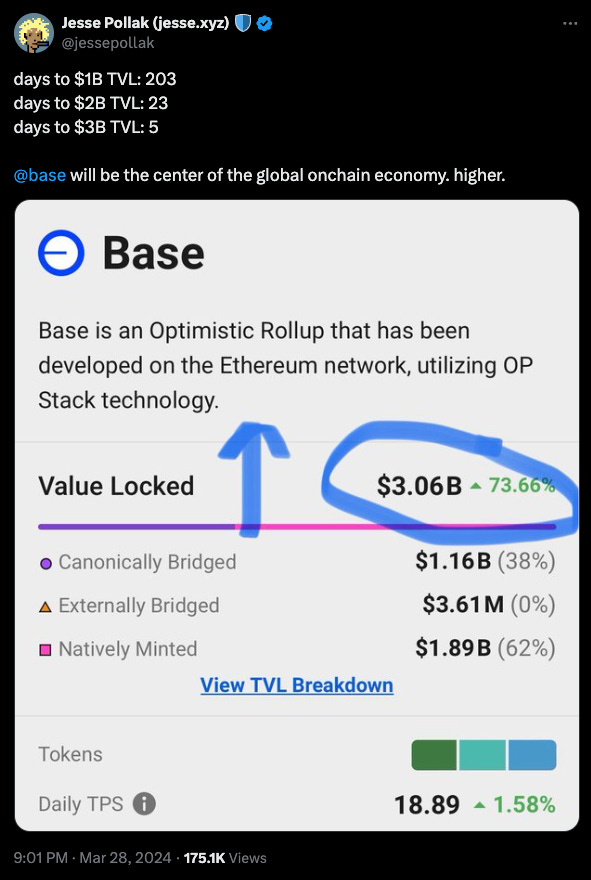Inside Base—the blockchain Coinbase launched to reach a billion users
Base has made promising progress less than a year after launch but more users and less centralization are key challenges
GM,
Coinbase is one of the leading names in Web3. When it makes a move, the industry sits up. In August 2023, it launched a layer-two (L2) blockchain—designed to help make transactions on Ethereum 10X cheaper and significantly faster.
The lofty goal is to onboard the next billion crypto users. Less than a year later and Base is showing signs of serious traction. Research from media outlet The Block found that Base was the second most active blockchain in May based on new tokens issued, behind only Solana.
It’s high time, then, for us to dig into what Base is.
Best,
What’s going on?
Coinbase is the most impressive company in Web3.
It is one of the first—it was founded in 2012
It is the most visible publicly traded Web3 company—it listed on the Nasdaq in 2021
It is one of the highest valued—Coinbase is worth nearly $60 billion today
To become a public company, Coinbase had to take a conservative and somewhat risk averse position in an industry that thrives on doing neither. For that reason, it received plenty of criticism. Indeed, Coinbase took more than five years for it to list so-called ‘alt coins’ for trading, having previously stuck to majors like Bitcoin and Ethereum.
Yet today, Coinbase looks very different.
Its exchange lists more 260 digital assets and over 300 different trading pairs—with more available to professional investment customers—and Base extends its reach into the developer ecosystem and edgier crypto scene.
That’s important because Coinbase’s business is reliant on more people owning and trading cryptocurrencies. Base is part of its effort to make Web3 more accessible to new users, whilst developing an onboarding experience that is easy. There is also a lot of money to be made.
One billion users will take time, but Base is already standing out from the considerable competition.
SO WHAT?
1. Why Base?
Base is a logical extension of the Coinbase business. Its exchange is highly regulated since it operates in the US (among other markets) and since Coinbase is a publicly traded company. That limits the work Coinbase can do advancing the Web3 industry.
Birthing Base has allowed it to interact with parts of the Web3 community in different ways. Coinbase has long invested in early stage projects, but, short of listing new tokens, it could not offer more direct support. Base is an entire playground where Coinbase can support any blockchain-based service: be that existing decentralized apps (dapps) like DeFi or trading, or more ambitious areas such as gaming, identity, social media and more.
Base launched with a major campaign called Onchain Summer in 2023, which attracted developers and even brands like Coca Cola. It is repeating the event this year.
Coinbase is also bringing its support to the industry more broadly.
The core of Base uses open source technology from Optimism, another L2 blockchain because, as we wrote last week, a lot of Web3 fundamental technology is developed through collaboration. Working together, both parties want to broaden Optimism’s tech to make it interoperable and support diverse services.
Finally, there is also money to be made.
This year’s surge in memecoin trading on Base earned the company $16.9 million during March alone, according to on-chain analytics. That’s collected through gas fees and while it isn’t always consistent because it is based on demand, Base is likely pulling in multiple million dollars per month even outside of buzzy periods.
2. How does Base look?
Base isn’t a memecoin chain, though the low fees lend themselves to new coins. It is making significant progress on DeFi and Web3 financial services.
Data from L2 Beat—which focuses specifically on L2 blockchains—shows that Base is now the second largest Ethereum L2 chain based on total value locked (TVL), i.e. the total value of all assets locked or staked on the platform. It even overtook Optimism’s own chain on that count.
Base has entered into hyper-growth mode on DeFi. A tweet in March from Jesse Pollack, the Coinbase executive who conceived and launched the chain, showed how the growth was rapidly increasing. That number has now more than doubled to reach $8 billion.
Coinbase launched Base to do more than redesign the wheel by competing with other L2s, it wanted to create mass adoption of Web3. While that will take some time—certainly more than nine months—there has been progress made in terms of the type of dapps that it supports.
One example is blockchain-based social network Farcaster, currently one of Web3’s hottest properties. The company just raised $150 million from a series of top-tier VC firms that include a16z—and it did so at a valuation of over $1 billion to make it a unicorn.
Founded by an early employee at Coinbase, Farcaster is built on Base and it takes a very different approach to social media by introducing communities, gatekeeping, tipping and more. Farcaster is, for now, a niche play within the Web3 community but it is the type of concept that Coinbase wants to seed in the hope that some of them will take off and find mainstream users.
That’s a strong pitch to developers when you have a prominent business like Coinbase to back it up.
3. A promising Base for the future
At less than a year old, Base is very much a work in progress. It is estimated to have around five million users. That’s not bad for Web3, but it is a long way from the one billion target—and it is fairly modest given Coinbase has an estimated user base of over 100 million.
The company is moving to bridge the gap between Base and its more traditional exchange business. It just acquired a company that builds on-chain tools for developers to make Base more attractive to builders and it is doing more for users, too.
Last week, it introduced a smart wallet as part of its push for those billion new users. Integrating Base is part of the push to make it friendly for new users. Base is used to carry transactions or mint NFTs, while there is a section for dapp discovery with a view to shepherding users to interesting services on Base.
Channeling users to chains like Base is a huge advantage that crypto exchanges have over any other companies since they have a user base that’s already interested in Web3. Given its position, Coinbase has the least ‘degen’ users who may be the most resistant to doing more than just financial trades.
Another area of work is to decentralize Base. Decentralization is important for blockchains since it gives them integrity and prevents the centralization that big tech firms like Google, Facebook and others are routinely criticized for. Yet, Base base began life as a fairly centralized network. Coinbase has said it is working to progressively decentralize its L2 and that is one important development to keep an eye on.
There is also plenty of speculation that Base will issue a token, as is standard for L2 blockchains. Coinbase has distanced itself from such a plan—”we do not currently plan to issue a new network token,” reads a note on the Base website—but still many in Web3 believe the Base token will come in due course.
It would certainly be huge if Coinbase did launch a token, but it seems unlikely given the current uncertainty around whether cryptocurrencies are viewed as securities in the US. There’s no doubt a Base token could massively boost Coinbase’s incomes and balance sheet, but such a view is unlikely until there’s more regulatory certainty. That could be the biggest challenge of all for Coinbase and Base.
News bytes
Lykke, a UK-based crypto exchange, is closing down after it lost $22 million following a hack
Binance, the world’s largest exchange based on trading volume, announced it has passed 200 million registered users
Kraken looks to be joining Coinbase on the public markets after Bloomberg reported that is considering raising a pre-IPO round of funding from investors—the round could be as high as $100 million
Robinhood has offered selected cryptocurrencies for trading for some time but it has jumped into the exchange game after it agreed to buy Bitstamp for $100 million
CoinGecko, the popular tracking service, says 1.9 million of its user email addresses were accessed after its email provider was compromised by an attacker—CoinGecko wasn’t impacted but the stolen emails are already being targeted with phishing emails
The Solana Foundation has expelled a group of validators, who help run its network, were found to have used their position to carry malicious attacks on users
That’s all for this week!
Share your feedback, questions or requests via email to: sowhat@terminal3.io






